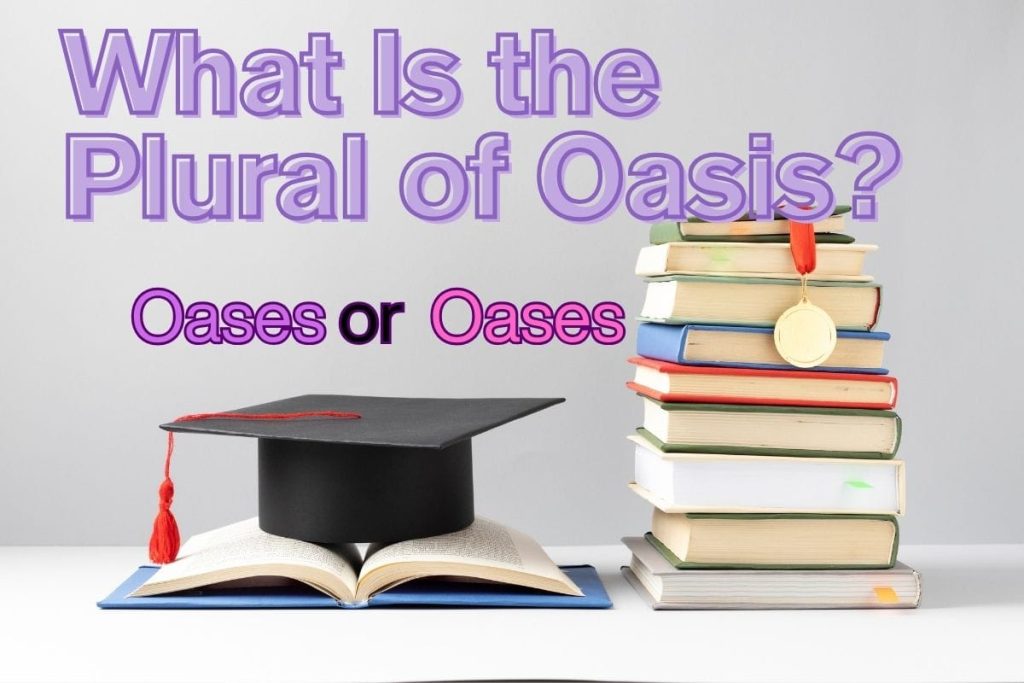What Is the Plural of Oasis? Grammar and Examples Inside
English grammar is full of fascinating patterns, and learning them can be rewarding and sometimes confusing, especially regarding irregular plural forms. One word that often stumps learners is “oasis.” At first glance, it might seem like the plural would be something straightforward like oasises, following the typical -es pluralization rule. But the correct plural form is actually “oases.”
Why does the plural look so different from the singular? The answer lies in the word’s origin, the rules of English grammar, and its connection to other irregular nouns. Whether you’re a student, a language enthusiast, or simply someone polishing your writing, understanding why “oasis” becomes “oases” is valuable and interesting.
In this comprehensive guide, we’ll dive into what “oasis” means, explore why its plural is “oases,” and show examples in real-world sentences. By the end of this post, you’ll not only know the correct plural of “oasis,” but you’ll understand why it’s correct.
What Is the Plural of Oasis?
Now to the core question: What is the plural of “oasis”? The correct plural form is “oases” (pronounced oh-AY-seez).
Why “Oases” and Not “Oasises”?
English is filled with irregular plural forms, many of which stem from the origins of the words. “Oasis” comes from Greek via Latin, and like many words from these roots, it follows a non-standard pluralization pattern. Instead of adding a simple -s or -es, words ending in -is often change to -es in the plural.
This transformation is common in academic, scientific, and formal vocabulary. “Oasis” becomes “oases,” just as:
-
Crisis → Crises
-
Thesis → Theses
-
Analysis → Analyses
These changes aren’t random; they preserve the original morphological structure from Greek and Latin, where the -is → -es transformation was grammatically standard.

Understanding the Grammar Rule
Words ending in -is (especially those of Greek origin) typically follow this irregular rule:
-
Remove the -is
-
Replace it with -es
Thus:
-
Oasis → Oases
-
Basis → Bases
-
Diagnosis → Diagnoses
Learning this pattern is especially helpful for advanced learners and writers who encounter academic or formal texts frequently.
How to Pronounce “Oases”
The plural form “oases” is pronounced /ˈoʊ.əˌsiːz/. It’s quite different from how it’s spelled, which can add to the confusion. Practicing it aloud helps reinforce the correct form and pronunciation.
Examples of Plural Forms of Oasis: Oases vs. Oasis
The most widely accepted and grammatically correct plural form of “oasis” is oases. This pluralization follows the pattern of some nouns borrowed from Greek, where the “-is” ending changes to “-es” in the plural form. Although the form “oasis” used as a plural does appear, especially in informal settings, it is generally not considered standard English.
The use of “oases” demonstrates a respect for the word’s etymological roots and maintains consistency with established grammatical conventions. While language is constantly evolving, adhering to these conventions ensures clarity and avoids potential confusion.
The debate over “oases” versus “oasis” as a plural highlights the dynamic nature of language and the influence of usage on grammatical norms. However, for formal writing and academic purposes, “oases” remains the preferred choice.
Examples Using “Oases”
The following table provides multiple examples of using “oases” in sentences. Each example is designed to showcase the use of the plural form in different contexts and grammatical structures.
| Sentence | Context |
|---|---|
| The caravan traveled for days, hoping to reach the distant oases. | Describing a journey |
| Several oases dot the Sahara Desert, providing vital resources. | Geographical description |
| Researchers studied the unique ecosystems found within these oases. | Scientific study |
| The discovery of new oases brought hope to the drought-stricken region. | News report |
| Ancient civilizations flourished near the oases, relying on their water supply. | Historical context |
| The shimmering mirage hinted at oases that were still miles away. | Descriptive writing |
| These oases are crucial for the survival of many animal species. | Ecological importance |
| The lush vegetation surrounding the oases contrasted sharply with the barren desert. | Visual contrast |
| The local communities have sustainably managed these oases for generations. | Community management |
| Protecting the oases is essential for preserving biodiversity. | Conservation efforts |
| The explorer documented the locations of several previously unknown oases. | Exploration and discovery |
| The oases provided respite from the harsh desert climate. | Relief from hardship |
| The presence of oases allowed for agricultural development in the arid landscape. | Agricultural impact |
| The strategic importance of the oases made them frequent targets in tribal conflicts. | Historical conflicts |
| The children played near the cool waters of the oases. | Everyday life |
| The traveler dreamed of finding oases filled with fresh water and shade. | Dreams and aspirations |
| The map showed the locations of several significant oases in the region. | Geographical maps |
| Many migratory birds rely on these oases as crucial stopover points. | Migratory patterns |
| The stories spoke of hidden oases that held magical powers. | Mythical tales |
| The government implemented policies to protect the dwindling water resources of the oases. | Government policies |
| They transformed their urban gardens into small oases of calm. | Metaphorical use |
| The library became one of the city’s oases, offering refuge from the urban noise. | Metaphorical use |
| During the festival, the park became one of the city’s cultural oases. | Metaphorical use |
| The museum served as one of the intellectual oases in the community. | Metaphorical use |
| For the weary travelers, the roadside inn was a welcome oases. | Metaphorical use |
| The community center provided oases of support for families in need. | Metaphorical use |
Examples Using “Oasis” (Plural)
While less common and generally discouraged in formal writing, the form “oasis” is sometimes used colloquially as a plural. The following examples illustrate such usage, though it’s important to remember that “oases” is the preferred form.
| Sentence | Context |
|---|---|
| We found several beautiful oasis along the route. | Informal travel narrative |
| The map showed a few oasis in that area of the desert. | Casual conversation |
| Those small oasis were a welcome sight after days of travel. | Informal description |
| I heard there are many hidden oasis in the mountains. | Anecdotal information |
| The explorer claimed to have discovered numerous oasis. | Unverified claim |
| The oasis provided much needed water and shade. | (Incorrect plural usage) |
| Are there any oasis nearby? | (Incorrect plural usage) |
| The oasis is far away. | (Correct Singular Usage) |
| Many oasis are in the Sahara Desert. | (Incorrect plural usage) |
| The oasis are a welcome sight. | (Incorrect plural usage) |
| This region is known for its many oasis. | (Incorrect plural usage) |
| I’ve never seen such lush oasis before. | (Incorrect plural usage) |
| The old maps showed several oasis. | (Incorrect plural usage) |
| They searched for oasis in the arid landscape. | (Incorrect plural usage) |
| The legend spoke of mystical oasis. | (Incorrect plural usage) |
| These oasis are vital for local wildlife. | (Incorrect plural usage) |
| The explorer documented the locations of the oasis. | (Incorrect plural usage) |
| The oasis provided respite from the desert heat. | (Incorrect plural usage) |
| The presence of oasis allowed for agriculture. | (Incorrect plural usage) |
| The strategic importance of the oasis was significant. | (Incorrect plural usage) |
| The children played near the oasis. | (Incorrect plural usage) |
| The traveler dreamed of finding oasis. | (Incorrect plural usage) |
| The map showed the location of the oasis. | (Incorrect plural usage) |
| Migratory birds rely on the oasis. | (Incorrect plural usage) |
| The stories spoke of hidden oasis. | (Incorrect plural usage) |
| The government protected the oasis. | (Incorrect plural usage) |
Other Words with Similar Plural Patterns
If “oasis” has an irregular plural form, are others like it? Absolutely. Once you learn the -is → -es transformation rule, you’ll start to notice several words that follow this same pattern, especially in academic or scientific settings.
Common Examples:
| Singular | Plural |
|---|---|
| Crisis | Crises |
| Thesis | Theses |
| Analysis | Analyses |
| Diagnosis | Diagnoses |
| Hypothesis | Hypotheses |
| Basis | Bases |
| Axis | Axes |
| Synopsis | Synopses |
| Parenthesis | Parentheses |
These words often appear in disciplines like:
-
Science: analysis, diagnosis
-
Mathematics: axis, hypothesis
-
Literature: thesis, synopsis
-
Philosophy: basis
Understanding this group of irregular plurals can dramatically improve your confidence when reading and writing in these fields.
Why They Follow This Pattern
As mentioned earlier, these words come from Greek and Latin origins. In Greek, the plural for words ending in -is was typically formed by changing it to -eis (pronounced -ees), which English adapted as -es.
Learning Tip: Keep a mental (or written) list of these words. Whenever you learn a new term ending in -is, look up its plural. Repetition and practice make these patterns easier to remember over time.
Usage Rules and Guidelines
The primary rule is to use oases as the plural form of “oasis” in formal writing and speech. This adheres to standard English grammatical conventions and respects the word’s etymological origins. Using “oasis” as a plural is generally considered incorrect in these contexts.
In informal settings, the use of “oasis” as a plural may be encountered. However, even in these situations, “oases” is the more grammatically sound choice.
Context and audience should be considered when deciding which form to use.
When writing for academic, professional, or formal audiences, always use “oases.” This demonstrates attention to detail and adherence to established grammatical norms. Misusing the plural form can detract from the credibility of your writing.
Common Mistakes to Avoid
One common mistake is assuming that “oasis” is already plural due to the “s” at the end. Remember that the “s” is part of the singular form.
Another mistake is simply adding an “s” to form “oasises,” which is incorrect. The correct plural is “oases,” following the Greek pluralization pattern.
Using “oasis” as a plural in formal writing is a significant error to avoid. Always double-check your work to ensure you’re using the correct plural form.
Here are some examples of incorrect and correct usage:
| Incorrect | Correct |
|---|---|
| There was many oasis in the desert. | There were many oases in the desert. |
| The explorer found several oasis. | The explorer found several oases. |
| The map showed a few oasis. | The map showed a few oases. |
| Those small oasis were a welcome sight. | Those small oases were a welcome sight. |
Practice Exercises
Test your understanding with the following exercises. Fill in the blanks with the correct plural form of “oasis.”
| Question | Answer |
|---|---|
| 1. The caravan hoped to find several _____. | oases |
| 2. The map indicated the location of numerous _____. | oases |
| 3. These _____ are vital for the survival of desert wildlife. | oases |
| 4. The explorer documented the discovery of several _____. | oases |
| 5. The _____ provided much-needed respite from the heat. | oases |
| 6. The presence of _____ allowed for agriculture in the region. | oases |
| 7. The strategic importance of the _____ was significant. | oases |
| 8. The children played near the cool waters of the _____. | oases |
| 9. The traveler dreamed of finding _____. | oases |
| 10. Migratory birds rely on these _____ as stopover points. | oases |
| 11. The stories spoke of hidden _____. | oases |
| 12. The government implemented policies to protect the _____. | oases |
| Question | Options | Answer |
|---|---|---|
| 1. Which is the correct plural form of “oasis”? | a) oasises, b) oasis, c) oases, d) oasi | c) oases |
| 2. The Sahara Desert has many _____. | a) oasis, b) oases, c) oasises, d) oasi | b) oases |
| 3. The explorer discovered several hidden _____. | a) oasis, b) oases, c) oasises, d) oasi | b) oases |
| 4. These _____ are crucial for the ecosystem. | a) oasis, b) oases, c) oasises, d) oasi | b) oases |
| 5. We found several _____ during our trek. | a) oasis, b) oases, c) oasises, d) oasi | b) oases |
| 6. The _____ provided much-needed shade. | a) oasis, b) oases, c) oasises, d) oasi | b) oases |
| 7. The _____ are home to unique species. | a) oasis, b) oases, c) oasises, d) oasi | b) oases |
| 8. The caravan traveled between _____. | a) oasis, b) oases, c) oasises, d) oasi | b) oases |
| 9. The _____ were a welcome sight. | a) oasis, b) oases, c) oasises, d) oasi | b) oases |
| 10. The _____ are essential for survival in the desert. | a) oasis, b) oases, c) oasises, d) oasi | b) oases |
Quick Tips to Remember
Struggling to remember that “oasis” becomes “oases”? Here are some tips and tricks that can help:
1. Use Mnemonics
Create a simple phrase like:
“One oasis, many oases in the desert’s embrace.”
2. Group Similar Words Together
Learn “oasis” along with “crisis,” “analysis,” and “thesis.” This helps you recognize and internalize the -is → -es pattern.
3. Flashcards or Apps
Use flashcards (physical or digital) with one side showing the singular form and the other showing the plural. Quiz yourself regularly.
4. Read More Academic or Descriptive Writing
Exposing yourself to high-quality writing will reinforce correct usage. Look for travel blogs, scientific papers, or literary essays that use these kinds of words.
5. Practice in Sentences
Write your own example sentences for both “oasis” and “oases.” Applying the word helps commit it to memory.
Frequently Asked Questions
Q1: Is it ever correct to use “oasis” as a plural?
A: While occasionally used in informal contexts, “oasis” as a plural is generally considered incorrect in formal writing and speech. “Oases” is the preferred and grammatically correct plural form.
Q2: Why is “oases” the correct plural form?
A: “Oases” follows the Greek pluralization pattern, where words ending in “-is” change to “-es” in the plural. This is due to the word’s etymological origins.
Q3: What is the origin of the word “oasis”?
A: The word “oasis” comes from Greek (ὄασις), which likely originated from an Egyptian word.
Q4: What are some other words with similar pluralization patterns?
A: Examples include crisis/crises, analysis/analyses, axis/axes, and basis/bases.
Q5: Is “oasises” an acceptable plural form?
A: No, “oasises” is not an accepted plural form. The correct plural is “oases.”
Conclusion
Understanding the correct plural of “oasis” is about more than just memorizing a vocabulary word—it’s about grasping one of the many fascinating quirks of the English language. While most English nouns follow simple pluralization rules, words like “oasis” remind us of the rich, diverse roots of English and its strong ties to Latin and Greek.
The correct plural form, “oases,” may not feel intuitive at first, but it follows a consistent rule shared by other Greek-derived words ending in -is. Knowing this helps you tackle not only “oasis” but also a whole class of academic and scientific terms with confidence.
We’ve explored the meaning of “oasis,” why “oases” is the correct plural, and how to use both forms properly. With examples, grammar breakdowns, and memory aids, you can avoid common mistakes and use the word accurately in any context.
So, the next time you’re writing about desert adventures, peaceful retreats, or metaphorical sanctuaries, you’ll know exactly how to say it right—one oasis, many oases.



